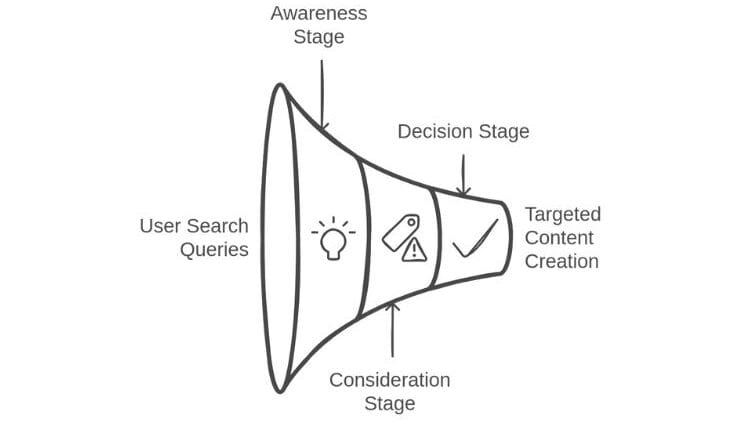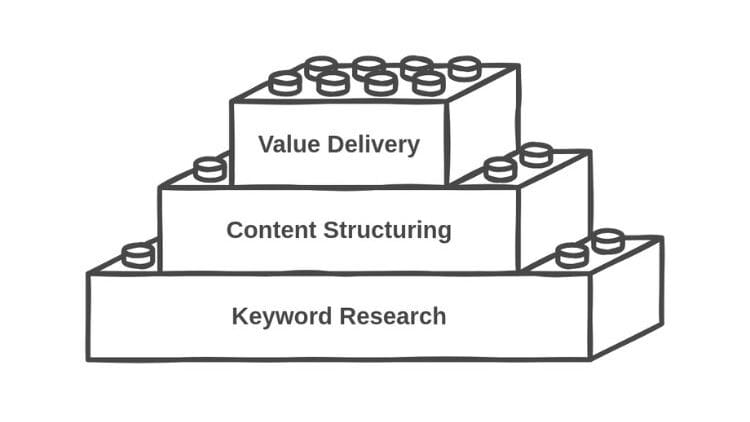The real SEO magic in today’s fast-paced SaaS market is not about keyword spamming. It’s about knowing your users, creating a compelling brand story that connects with them, and being the thought leader in your niche. What if you didn’t just rank higher on search engines but also became the go-to resource for your audience?
In this guide, we will walk you through a 12-step framework to build your very first SaaS SEO strategy from scratch. This is to boost your search visibility, drive meaningful growth, and position your brand as an industry leader. It’s no secret that 61% of marketers say SEO and organic growth are the top priorities. It’s time to dive into how you can use SEO to build lasting value and put your SaaS business ahead of the rest!
1. Define Your Unique Value Proposition (UVP)
Your Unique Value Proposition (UVP) is the first step to building a solid SaaS SEO strategy. Your SaaS product has to be different in a crowded market and your UVP is what makes you different. That’s what your customers love about your product and why they choose you over the competition. A good UVP not only gets you the right customers but also forms the base of your entire SEO strategy.

Suppose you have a project management SaaS tool for remote teams. One of your UVPs may be that your software works so seamlessly with any popular collaboration platform like Slack, Zoom, and Google Meet that teams can coordinate their projects without the need to switch between platforms. The unique aspect of this feature makes your product very appealing to companies that have remote workers who require a simple means of collaboration and task management.
Once you know your UVP, make sure that it’s communicated consistently across all your content, all your landing pages, and all your blog posts. For instance, your homepage should quickly announce that your tool connects to the same platforms your remote teams already use. It makes sure visitors understand why your SaaS product is an absolute need for their particular needs.
Without a strong UVP, all your future SEO will fall flat, as your content won’t resonate with the right audience. This will also help you get your keywords right, so instead of focusing on “project management software,” you target keywords like “project management tool for remote teams.” With a clear UVP, you know your content will attract the right traffic, resulting in higher conversion rates.
2. User Intent Mapping
After you have defined your UVP, you’ll need to map out user intent. To equip yourself with the knowledge of what exactly your users are searching for and why you need to figure out the kind of content that really solves their problems. Think about the project management tool that was built for remote teams for instance.
When someone is searching for “best project management tools” they’re aware of a problem and they’re looking for possible solutions. Compare how your solution benefits remote teams with one another and highlight how your tool integrates with Slack and Zoom.
This is exactly the approach that has worked so well for Slack, not just with the “team communication software” but by addressing the most painful problems of remote work like miscommunication and poor collaboration. This lets them talk about those issues, rather than rundown features.
Understanding the audience’s needs, problems, and information-seeking behavior is called user intent mapping. Instead of shooting for generic keywords, create content that answers questions.
For example, if someone searches ‘how to manage remote teams effectively’ they are already a little further down the path and are looking for a solution. In this case, your content will be offering actionable advice to people on how to overcome those remote work challenges, and positioning your tool as the answer.
An important note is that 80% of all the search queries are informational. What users want is to solve a problem, not to click through a list of options. By mapping user intent, you make sure your content is serving the purpose your user is trying to achieve. That translates to better engagement and conversions.

3. Content Pillars
Once we’ve mapped out the user intent, the next step is to develop content pillars. They’re broad topics and topics that are in line with what your brand is an expert on and really hit home with your target audience. When focusing on core pillars, you become the preferred brand to people and a source of information they find value in.
Take HubSpot, for example. Each of the key pillars of HubSpot’s content empire – inbound marketing, sales, and customer service – was built around the core pillars. There were very direct correlations between the services that HubSpot offered and the questions that their customers were asking them. HubSpot has become a thought leader in the marketing and sales space by consistently producing high-quality content around these topics.
To construct your content pillars, first, choose 3 to 5 central themes that are essential to your product or message that appeals to your target audience. Say, for example, you’re using the project management tool for remote teams and your pillars could be about: remote team collaboration, project management best practices, task management tools, and improving team productivity. Your target audience’s pain points and interests are these topics and they are the basis of your content strategy.
After you have found out your pillars, write in-depth pillar-based content with deep insights about these topics. This could be a guide, eBook, blog, or video series. The aim is to make sure each piece of content answers the questions in a specific way but also establishes you as the authority on a topic, which translates into more organic traffic and trust in your brand.

4. SEO-First Content Framework
It is very important to adopt an “SEO first” approach as you begin to make some content. In simple terms, this means you have to incorporate SEO tactics from the getting started of the content creation process and not as an afterthought. From the outset, – leading SaaS companies like Intercom – have shown they understand this pretty well. They make sure that every piece of content has the intention to rank well in the search results and with maximum impact on their target audience.
As an example, let’s consider the project management tool for remote teams. Before you even begin writing content, you should do proper keyword research to know what keywords or phrases your potential users are searching for. You might find terms like “best project management tool for remote teams”, “how to manage projects remotely” or “collaboration tools for distributed teams” using Google Keyword Planner or Ahrefs. These are the user intent keywords, the ones you need to include in your content to make it discoverable.
After finding the right keywords, arrange your content around them, and make sure you’re still delivering valuable information to your readers. For blog posts or landing pages, start with high-impact, long-tail keywords and just deliver in-depth information to answer user queries. This is the foundation of the “SEO-first” framework: It’s content that ranks well and meets the needs of users.
5. Technical SEO
When you have a content strategy in hand, it’s time for the technical aspects of SEO. Things like improving page speed and making sure your site is mobile-friendly can make a huge difference to your organic traffic.
Let’s say your site is somehow slow to load or not mobile-optimized, your users will leave before they interact with your content. This is bad for your rankings because search engines take bounce rates into consideration when ranking sites.
However, a fast and mobile-friendly site gives your users a better experience and helps your search engine visibility. You can start by running an audit of a site using tools like Google Search Console or Screaming Frog to detect technical problems like slow load times or broken links. Compress images and optimize code for better site speed, and be sure your site is mobile responsive.
To make your content discoverable to search engines, make sure search engines can crawl and index your content by keeping your site structure clean, and using the proper heading tags and an XML sitemap.

6. Visual Storytelling
In today’s world, visuals aren’t just eye candy – they’re an integral part of your SaaS SEO strategy. For example, Drift is using interactive content such as chatbots and quizzes to attract visitors, collect leads, and generate conversions. We see from their approach how visuals can help users stay on your site longer, and how content becomes more memorable.
If you are creating content for your project management tool, picture how infographics, videos, or interactive materials like product demos or quizzes could help your team stay informed. Not only do these types of visuals improve user engagement, but they also encourage sharing. Research has found that content with visuals is shared 40 times more than content without visuals. It will boost the reach of your content, increase traffic to your site, and even get you some valuable backlinks.
To use your visuals to tell stories, ensure your visuals support your brand’s messaging and clarify complex ideas. Let’s say a video tutorial on how your project management tool can simplify workflows will not only educate visitors but also make the information more digestible. Infographics can also be used to break down complicated topics in a visually appealing way, and infographics can also be used to outline your tool’s key features.
7. Build a Strong Internal Linking Strategy
When your content grows, building a good internal linking strategy is crucial for both users and search engines. Internal links are signposts that tell visitors where they should go on your site and which paths to take to find more of what they’re looking for. It also enhances the search engines’ understanding of how the structure and hierarchy of your content looks, countering that positively to your rankings.
Content pillars are important here, as we discussed in the previous steps. These pillars are the core areas of what you know and help you to know your content pillars, you can also tell which pages should link to other pages.
For instance, let’s say your blog post about project management best practices is one of your content pillars, and you should link it to some other articles related to team collaboration or using some particular features of your project management tool. But it also makes it easy to find your content as a user, and easier for search engines to understand your most important pages.
First, take a look at your content pillars and see what articles naturally lend themselves to internal linking for you. Make sure that each page has internal links that lead your users through your site. Additionally, make use of descriptive anchor text that flows naturally in your content and feels like a useful bit for the user experience.

8. Building a Backlink Ecosystem
Now that we’re moving forward in building your SaaS SEO strategy, one really important thing we need to think about is building a good backlink ecosystem. Backlink, or links from other reputable sites to your own, works as the votes of confidence for your content, and search engines receive the signals that your site is a trustworthy and authoritative one.
Instead of accumulating a large set of backlinks, concentrate more on obtaining a few high-quality, authoritative backlinks. And strategies such as guest blogging, co-marketing initiatives, and industry partnerships can be used to achieve this.
If, for instance, your SaaS product helps businesses manage projects better, collaborating with well-known project management blogs or sites might bring you useful backlinks from trusted sources.
By diversifying the sources of your backlinks and focusing on quality rather than quantity, you’ll establish your SaaS business as a trusted leader in your niche. Building this strong backlink profile helps boost your organic visibility and strengthens your overall SEO strategy.
9. Leveraging Social Proof
So now you’ve fortified your content strategy and your backlink profile, it’s time for social proof to help boost your trust. Social proof is equally as important as it influences user decisions and your SaaS SEO strategy. Positive customer reviews on G2, Capterra, or Trustpilot are very strong signals for both search engines and potential customers that your SaaS product brings value.
Consider, for example, if users see glowing testimonials from happy customers talking about how your project management tool made their workflows better, it builds trust and makes it easier for other users to take action. Search engines are told your product is trusted’, which can lead to better search rankings.
Instead of letting customers find you, reach out to them actively to solicit reviews via email request, follow up after a successful demo, or check in with them. Put up these positive reviews on your website and social media to build credibility and drive further audience.
In fact, 95% of consumers read online reviews before making a purchase, so it’s important to leverage this to increase trust and conversion.
10. Web Personalization
SaaS companies have been using personalization as a game changer to stand out and boost their SEO efforts. Take Netflix, for example. The reason for its success is a focus on offering recommendations tailored to user preferences that make the experience more engaging and bring back users.
CRO tools and Web personalization work in the same way for your SaaS business. You provide your visitors with a better user experience by tailoring content, calls to action (CTAs), and search results to the unique needs and behavior of your visitors. By allowing this customization it helps to reduce bounce rates, increase conversions, and also builds stronger brand loyalty.

If users feel your website is speaking to their needs (or at least the needs they want it to be), it not only improves the overall experience but also sends positive signals to search engines. If a website offers relevant, personalized content, search engines reward it accordingly by giving it a higher rank.
And we can also increase conversion rates by up to 20% through personalization. In addition, 40 percent of online customers say they have made a purchase because of a personalized experience. Because of this, behavioral data is an important tool to use to inform and create your content strategy and create a seamless, valuable experience for your visitors.
11. Ongoing Monitoring and Adaptation
With a solid SEO strategy in place, the process still requires continuous monitoring and adjustment. Without it, you will be missing out on important shifts in trends, or algorithm updates that impact your rankings. Keep an eye on your regular SEO key metrics like organic traffic, bounce rates, and conversion rates to track your success and your improvement points respectively. Tools such as Google Search Console and other SEO tools give really good insights about the performance of content and what you need to adjust for.
It’s always of great advantage to stay in tune with the updates on the search engines as they evolve, with frequent reworking of their algorithm, to ensure that your strategy is in place to cope and in place to remain competitive. SEO is a process and as such needs constant fine-tuning to perfection. To stay perfect this SEO needs to be continuously optimized in order to be the most efficient at serving your business goals.
12. “SEO-First” Product Roadmap
For long-term success, you must integrate SEO into your product roadmap. SEO is considered very important for so many successful SaaS companies that they include SEO at the very product development stage. That way, your product is set up to be optimized for search visibility from the start.
Working with your SEO team early in the product discussion allows you to craft content, features, and user experiences that naturally fit with the keywords and the user intent that matter most. This proactive strategy will help you tap into opportunities to reinforce the product’s visibility and importance, thereby enhancing its market fit. Running your product with an SEO-first mindset can make it rank better, attract more organic traffic, and convert visitors better, all of which add to sustainable growth.
Conclusion

However, in order to actually make it happen in an SEO world, the ranking is not the only thing you need to succeed. Long-term growth is built on strong branding, delivering exceptional user experiences, and building thought leadership.
Rather than just digging in and trying to gain renown for doing something searchy, focus on building up a nice foundation with a great value proposition, that delivers real value to your audience, and adapting to the ever-changing search landscape. In doing so, you’ll not only boost your rankings but also establish your brand as a source your audience can continue to rely on in the future.




